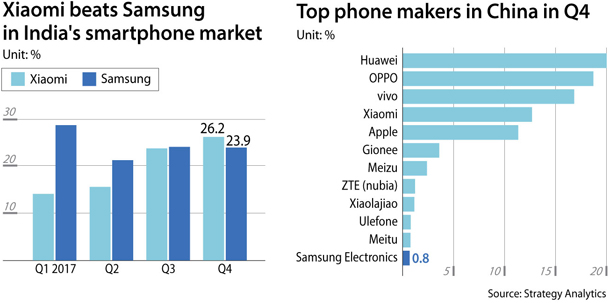Samsung sales slump in China

The smartphone market tracker Strategy Analytics on Sunday reported that Samsung had a 0.8 percent market share, less than half of the 1.7 percent that it predicted in a report earlier this year.
This also pushes down Samsung’s annual market share in China from an estimated 2.4 percent to 2.1 percent and its rankings from a tentative eighth to a confirmed ninth.
The Chinese market is a hard one for the Korean electronics giant, as it is sandwiched between its American rival Apple in the premium segment and fast-growing Chinese phone makers that can offer lower prices.
Unlike Samsung, Apple clawed its way back into double-digit market share territory in the fourth quarter last year, putting up 11.5 percent. It is the first time since the first quarter of 2016 that the U.S. phone maker had a market share above 10 percent in China.
Last year was rough for Apple, as it had to face criticism from iPhone users worldwide over a battery scandal that broke out after the company admitted it intentionally reduced the processing power of some iPhones to prevent the devices from unexpectedly shutting down. However, premium phone buyers in China overwhelmingly chose the iPhone over Samsung’s Galaxy series.
Chinese brands’ strategy of playing up their lower prices worked for them at home. The top 10 phone manufacturers in China in the fourth quarter were all homegrown companies except for Apple, which came in at fifth.
Even in India, where Samsung has had perennial strength, China’s Xiaomi beat it in the last quarter of 2017. Xiaomi accounted for 26.2 percent of the Indian smartphone market while Samsung followed with 23.9 percent. It is the first time in roughly six years that Korea’s top smartphone vendor was knocked off the top spot in India.
Up until the first quarter of last year, Xioami took up less than half of Samsung’s market share in India, with Samsung standing strong at 28.6 percent and the Chinese company trailing with 14.1 percent. But the Chinese competitor grew quickly over the course of 2017 and finally overtook Samsung.
The Korean company still leads the global smartphone market, but it is scrambling to restore its solid status in China and India, the two largest smartphone markets in the world.
At the end of last year, Samsung released a Chinese version of its virtual assistant Bixby for its Galaxy S smartphones. Chinese is the third language that Bixby supports after Korean and English. The company also replaced the chief of its Chinese corporation and revamped its local sales teams to bolster sales.
Just last month, the company also held a Galaxy S9 series launch event in Guangzhou, China, attended by roughly 2,500 people from Chinese companies and media. At the event, Samsung announced it will customize AI and Internet of Things-based services for Chinese consumers by partnering with Chinese tech companies like Baidu, Alibaba and Mobike.
In India, Samsung is focusing on a budget model, the Galaxy On7, as there is strong demand for low-priced phones in the market. The latest version of the series, the Galaxy On7 Prime, was released in India in January.
“As the Galaxy S9, released last month, has received positive feedback from both China and India, we expect to recover our market presence in the first quarter this year,” a Samsung spokesperson said.
Samsung will use a two-track strategy, promoting its flagship Galaxy S and Galaxy Note phablets for the premium market and bolstering sales of its lower-priced Galaxy J and Galaxy A phones in emerging markets where consumers demand cheaper phones.
Industry insiders say the future of Samsung’s smartphone business could depend on the company’s forthcoming foldable phones. Samsung is expected to introduce prototype foldable phones as soon as next year’s Consumer Electronics Show in Las Vegas.
“A customized strategy for each market and innovation in smartphone hardware, like in the case of foldable phones, will have to come together for survival,” said Yoo Seung-ho, a professor of industrial convergence at Hanyang University.
BY SOHN HAE-YONG [kim.jeehee@joongang.co.kr]










with the Korea JoongAng Daily
To write comments, please log in to one of the accounts.
Standards Board Policy (0/250자)